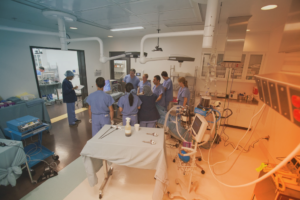Life science companies of all shapes and sizes rely on preclinical contract research organizations (CROs) to generate the data and reports required to bring their innovations to market.
To do this effectively, and in a capital efficient manner, each entity needs to understand what they need from the other, when they need it, why they need it and ultimately what happens with the end product, the finalized preclinical study report.
Formerly GCMI’s Preclinical Program Director, Deepal Stevenson, M.S., is now Director of Preclinical Research for Artivion, a leading cardiac and vascular surgery company focused on aortic disease.
Deepal shared her insights on the collaboration needs between preclinical CROs and their clients, along with what clients should look for in a preclinical CRO, in the following Q&A with Write2Market’s Paul Snyder.
 Q: What do you need, and look for, in a preclinical CRO?
Q: What do you need, and look for, in a preclinical CRO?
A: A clean audit record with regulatory agencies. Attention to details like calibrated equipment, qualified study personnel especially study directors, veterinarians, vet techs with specific experience in the type of device being tested and/or corresponding animal model or models. Flexibility, mostly to accommodate surgeons’ schedules and availability. The ability to meet tight timelines and incorporate sponsor’s [or client’s] unique needs in protocol and reporting.
Q: What needs to happen on the client’s end when developing a preclinical study?
A: Most sponsors have a pre-submission return from the U.S. FDA or other regulatory body with feedback that guides how the safety and efficacy of a device needs to be evaluated. When sponsors are designing a preclinical study they need to use that feedback to ensure the study and its results address that feedback adequately.
In certain cases, sponsors prefer to design a worst case protocol to ensure regulatory bodies respond with no further questions from the results of the preclinical study. The type of study depends on the stage of the device development process and level of confidence the team has in a successful outcome.
With regulatory feedback and other documents in hand, e.g. guidance documents, ISO standards, design description documents, user needs documents and failure mode analyses, the preclinical study design needs to take into consideration requirements from multiple sources. For example: one failure mode could be inaccurate delivery of a device. The study should demonstrate the absence of that failure mode within the bounds of appropriate acceptance criteria.
Q: What should the CRO contribute to the protocol development?
A: Sponsors are responsible for the following:
- A detailed device description,
- Test article characterization, and
- Communicating feedback from the regulatory body on preclinical testing requirements to include usability and biocompatibility.
The CRO should be responsible for providing details including, but not limited to, animal model, veterinary care, medications and the procedure itself, incorporating feedback from the sponsor or client. One important note: the number of people on sponsor or client’s end that perform the review of the protocol typically include preclinical subject matter experts, R&D engineers, and occasionally clinical research, quality and regulatory affairs personnel. These subject matter experts examine a variety of items in a preclinical study protocol like reference to guidance documents, specific standards, device description and use, incorporation of regulatory feedback and GLP compliance.
Q: What’s on the CRO, what’s on the client or sponsor?
A: Compliance to regulations like GLP or standards like ISO 10993 is on the CRO. While the sponsor should always audit potential CRO partners, it is the CRO’s study director’s responsibility to ensure compliance with standards and regulations to ensure they and the sponsor don’t suffer for non-compliance especially if the study has a good outcome.
Provision of, and adherence to timelines, is on the CRO. It is one of the most critical elements for the CRO to deliver upon because the client is often “on the clock” with a regulatory agency with a hard deadline. A slip, delay or extension to the timelines can have grave financial impacts on the company.
Sponsors also often perform studies in response to an urgent request from FDA or regulatory body. If the regulatory submission that is reliant on a preclinical study does not get approval in time because the preclinical lab does not have availability, it can delay further production.
Watch out for far ahead planning needs due to high demand and a backlog of requested preclinical studies and supply chain issues. A one day delay can matter a great deal to investors and shareholders no matter the size of the company. Some financing agreements are dependent upon hard dates and specific deadlines that can make the difference in very high financial amounts.
When it comes to budgets, the responsibility lies with the sponsor or client at first. Budgets are often planned years in advance for preclinical studies. In some cases those funds may not be transferred from quarter to quarter, which makes timing, planning and execution critical. The budget responsibility shifts to the CRO once the scope and fee for the study have been agreed to.
Editor’s note: Not all preclinical CROs estimate the costs of their studies in the same way or format. Hard to find those dollars once the quarter is over. We encourage you to read our overview or primer on Common Costs in Preclinical Research.
 Q: What happens with a preclinical study report once the sponsor has it?
Q: What happens with a preclinical study report once the sponsor has it?
A: Once in hand, several stakeholders on the client or sponsor side will need to review the report – in most cases the same stakeholders that contributed to or reviewed the test protocol. It is not helpful if the report is delivered to the sponsor one or two days prior to that requested delivery deadline. Even though a sponsor tries to plan timelines carefully, allowing sufficient time for that review, the CRO should make every effort to provide that report as early as possible.
Sponsors will look for attention to detail, ensuring the pre-submission feedback is adequately addressed in the report, ensuring any adherence to guidance and compliance is called out, ensuring that the data provided is detailed even though it may sound redundant or repetitive, including pictures, detailed contributing scientist reports, case report forms, detailed methods even though they’re described in the protocol.
When the stakeholders have completed their reviews, the primary sponsor contact with the CRO will pass those back to the study director who will then address them, if there are any. Once the report is fully signed off upon by the sponsor, it is usually uploaded to the sponsor’s quality management system (QMS) for reference in design description, usability and other documents.
In preparation for formal report submission to the regulatory agency, sponsors extract data from the preclinical reports to provide a high level overview of the findings, in an effort to present the data in an easy to read format. Often, this data needs to fit certain regulatory submission templates.
An executive summary in the final report is especially useful. T3 Labs and GCMI do an excellent job of this. Sponsors can include it with the submission document supplemented with tables of their own creation pointing to sections in the report demonstrating where and how they addressed the agency’s feedback, saving the reviewers’ time from having to scroll through pages and pages of content to find answers to the feedback originally provided.
Q: What else? What else would you like your internal colleagues to know about the subject?
A: It is critical for sponsors or clients to audit the CRO for capabilities mentioned here.
Every CRO in compliance with GLP has their own protocol and report template. Some have separate IACUC and study protocols, some combine them. I find separate protocols more convenient. It is easier on the sponsor’s end to take the protocol and attach it to a submission or QMS compared to a longer protocol combined with IACUC. I used to think combined was the way to go, but my view there has changed. It is easier to change the protocol when it’s separate from IACUC.
When studies are tied to approval of a product, every stakeholder and participant needs to bring their “A Game” to its design, execution and review.
Lastly, for many sponsors and labs test article characterization is a struggle. Manufacturing and R&D teams need to do everything they can to provide documentation to test article characterization. I can be a timely struggle to track down that documentation unless it’s in the QMS.
The GCMI and T3 Labs team thanks Deepal for sharing these insights with us.
About GCMI
GCMI accelerates the development, testing, training and commercialization of innovative medical products that improve quality based outcomes and delivery of healthcare for patients. We are a trusted, proven industry-leading preclinical CRO for medical devices and other medical products. We’re an AAALAC accredited facility that conducts feasibility, proof of concept, safety, and GLP medical device testing for studies in any therapeutic area and in small and large models.
Why GCMI? It’s all about flexibility, accountability, quality, compliance and accreditation, our scientific acumen and commitment to value. Learn more.
